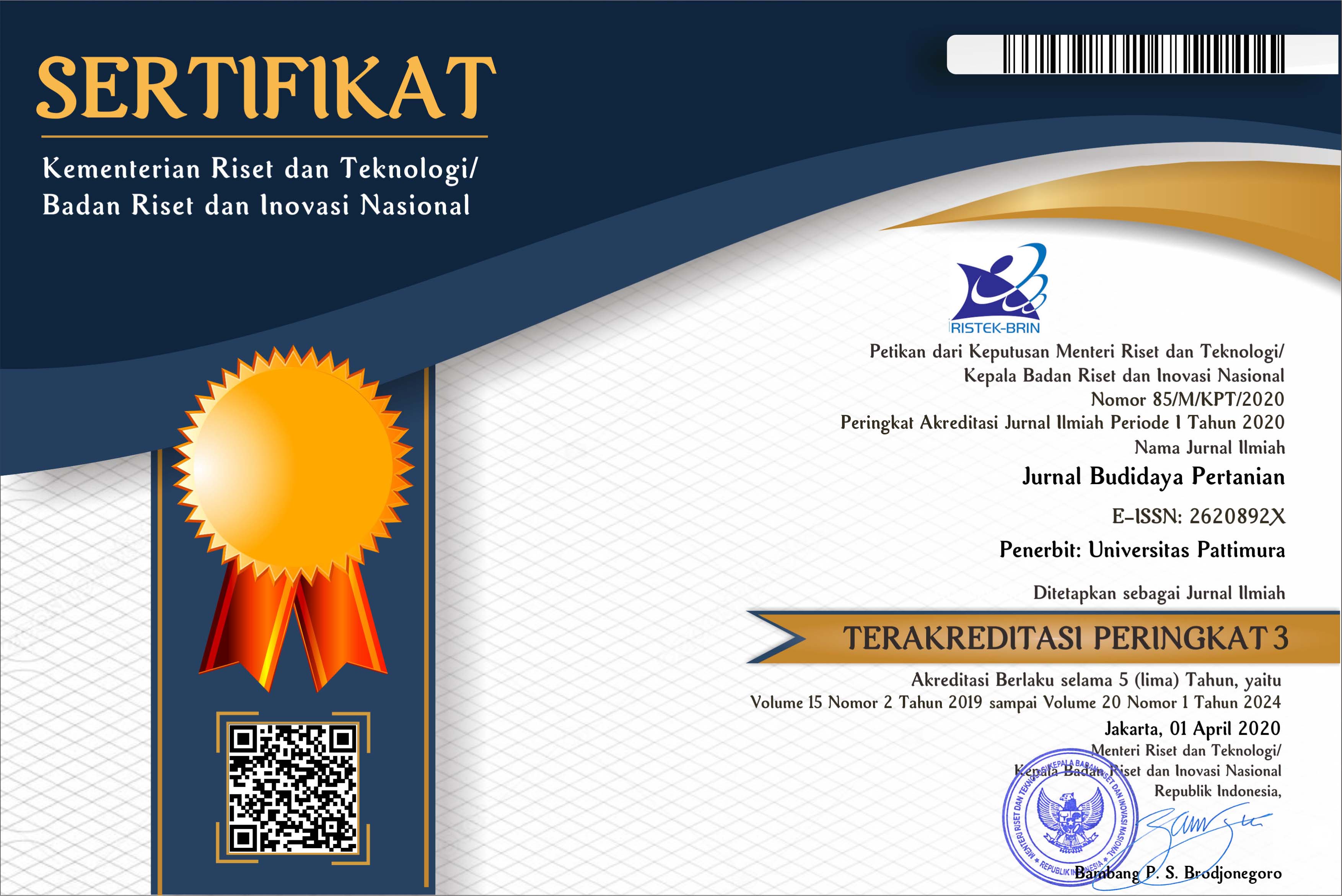The Effectiveness of Leaf Powders from Several Types of Plants as Botanical Insecticides Against Mung Bean Beetle Pest (Callosobruchus chinensis L.) in Storage
Abstract
Mung bean (Vigna radiata L.) has the third economic value among the legume group in Indonesia, after soybeans and peanuts. In storage, mung beans are often attacked by the beetle pest Callosobruchus chinensis L.; thus, it is necessary to control these pests. One way to control it is by using botanical insecticides derived from several types of plants, including lime leaf powder, noni leaf powder, nutmeg leaf powder, and lemongrass leaf powder. The purpose of this study was to obtain the most effective type of plant powder in controlling C. chinensis pests on mung bean seeds in storage. The study was conducted at the Plant Pest Laboratory of the Faculty of Agriculture, Pattimura University, which took place from November 2020 to January 2021. The study was conducted using a Completely Randomized Design with 4 treatments, namely DJ (15 g of lime leaf powder per 100 g of mung bean seeds), DM (15 g of noni leaf powder per 100 g of green bean seeds), DP (15 g of nutmeg leaf powder per 100 g of green bean seeds), DS (15 g of lemongrass leaf powder per 100 g of green bean seeds) and K (control, without leaf powder). Twenty imagos of C. chinensis were used in each treatment, and the experiment had 3 replicates. The variables observed included the initial symptoms after treatment, the mortality rate of the test insects, and the mortality of the test insects. The results showed that the DS (lemongrass leaf powder) and DM (noni leaf powder) treatments resulted in the mortality of the test insects of 93.33% and 91.67%, respectively, and were more effective than the other two treatments, namely DP (nutmeg leaf powder) and DJ (lime leaf powder) as well as controls.
Downloads
References
Asmaliyah, E.T. Wati H., S. Utami, Kusdi, Mulyadi, Yudhistira dan F.W. Sari. 2010. Pengenalan Tumbuhan Penghasil Pestisida Nabati dan Pemanfaatannya Secara Tradisional. Palembang, Pusat Litbang Produktivitas Hutan, Bogor. ISBN: 978-602-98588-0-8
Bonanto, S. 2008. Manajemen hama gudang. Buletin K4 (Kualitas, Keselamatan dan Kesehatan Kerja). PT. Charoen Pokphan, Balaraja, Indonesia. 5:1-4.
Cania B, E. dan E. Setyaningrum. 2013. Uji efektifitas larvasida ekstrak daun legundi (Vitex trifolia) terhadap mortalitas larva Aedes aegypti. Medical Journal of Lampung University 2(4):53-60. ISSN: 2337-3776.
Dinata, A. 2008. Atasi jentik DBD dengan kulit jengkol. Inspirasi & Ide Litbang P2B2 Inside 3(2):59-66
Ginting, B., T. Barus, L. Marpaung dan P. Simanjuntak. 2014. Uji toksisitas ekstrak daun Myristica fragrans Houtt dengan meode brine shrimp lethality test (BSLT). Seminar Nasional Kimia. Universitas Sumatera Utara, Medan.
Harinta, Y. W. 2003. Pengaruh Tepung Cabai Merah Terhadap Mortalitas dan Perkembangan Callosobruchus Analis Pada Biji Kedelai. Laporan Hasil Penelitian. LPPM Univet Bantara, Sukoharjo.
Hidayat, F.K. 1999. Ekstraksi Minyak Atsiri Dari Daun Jeruk Purut (Citrus hitslik D) Pada Skala Pilot-Plan. Institut Pertanian Bogor, Bogor.
Kardinan, A. 2001. Pestisida Nabati Ramuan dan Aplikasinya. PT Penebar Swadaya. Jakarta. ISBN: 979-489-506-7.
Kundra. 1981. Dinamika Populasi. Institut Pertanian Bogor. Bogor.
Novizan. 2002. Membuat dan Memanfaatkan Pestisida Ramah Lingkungan. AgroMedia Pustaka, Jakarta. ISBN: 979-3084-66-9.
Prijono, D. dan Dadang. 2008. Insektisida nabati; Prinsip, Pemanfaatan dan Pengembangan Bogor: Departemen Proteksi Tanaman Intitut Pertanian Bogor, Bogor. ISBN: 9789792535716.
Priyono, 1988. Pengujian Insektisida. Penuntun Praktikum. Jurusan Hama dan Penyakit Tumbuhan, Fakultas Pertanian IPB, Bogor.
Regnault-Roger, C. and A. Hamraqui. 1996. Efficiency of plants from the south of France use as traditional protectants of Phaseolus vulgaris L. against its bruchid Acanthoscelides obtectus (Say). Journal of Stored Products Research 29(3):259-264. https://doi.org/10.1016/0022-474X(93)90008-R.
Rukmana, H.R. 2002. Mengkudu, Budidaya dan Prospek Bisnis. Kanisius, Yogyakarta. ISBN: 979-21-0492-5.
Setiawati, W., R. Murtiningsih, N. Gunaeni dan T. Rubiati. 2008. Tumbuhan Bahan Pestisida Nabati dan cara Pembuatannya untuk Pengendalian Organisma Pengganggu Tumbuhan (OPT). Balai Penelitian Sayuran, Bogor. alai Penelitian Tanaman Sayuran. Blitbang Pertanian, Bogor. ISBN: 978-979-8304-58-3
Soemirat, J. 2005. Toksikologi Lingkungan. UGM Press, Yogyakarta. ISBN: 978-979-420-976-9.
Somaatmadja. 1998. Kacang Tanah. Penebar Swadaya. Jakarta.
Sudarmo, S. 2005. Pestisida Nabati Pembuatan dan Pemanfaatanya. Yogyakarta. ISBN: 978-979-21-1004-3.
Suyanto, F. 2009. Efek Larvasida Ekstrak Kulit Buah Manggis (Garcinia mangostana L.) Terhadap Larva Aedes aegypti L. Fakultas Kedokteran Universitas Sebelas Maret. Surakarta.
Tompo, A. dan A.P.S. Idris. 2016. Prevalensi dan identifikasi penyebab penyakit yang pengahambat penetasan telur udang windu (Penaeus monodon Fabr) Di Hatcheri Kabupaten Takalar. Jurnal Pendidikan Teknologi Pertanian 2:129-134. DOI: 10.26858/jptp.v2i2.5168.
Ujianto, L., N. Basuki, Kuswanto dan A. Kasno. 2011. Evaluasi ketahanan hibrida hasil persilangan kacang hijau dan kacang uci terhadap Callosobruchus chinensis L. (Coleoptera: Brucidae). Jurnal HPT Tropika 11(2): 130-138.. DOI: https://doi.org/10.23960/j.hptt.211130-138
Wardani, R.S., Miftakhudding, K. Yokorinanti. 2010. Pengaruh konsentrasi ektrak d.aun tembelekan (Lantana camara) terhadap kematian larva Aedes aegypti. Jurnal Kesehatan Masyarakat Indonesia 6(2): 30-38. ISSN: 1693-3443.
Copyright (c) 2022 Prisilya Makuku, Muhammad R Uluputty, Jeffij V Hasinu

This work is licensed under a Creative Commons Attribution-ShareAlike 4.0 International License.

 Accreditation is valid for 5 years, starting from Volume 15 Issues 2 December 2019 up to Volume 20 Issue 1 June 2024.
Accreditation is valid for 5 years, starting from Volume 15 Issues 2 December 2019 up to Volume 20 Issue 1 June 2024.






